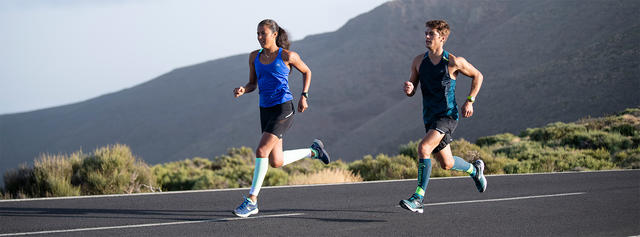Do you want to run faster? Are you stuck in a training or racing rut? Have your times recently remained stagnant? Totum Physiotherapist and competitive runner Katie Snowden provides you 3 key tips to improve your speed and performance.
Midfoot / Forefoot Running
A tremendous amount of research has been conducted to determine the proper foot strike mechanics during the running gait. Heel striking often results in overstriding, overuse of the soft tissues of the shins, and decreased efficiency of the stride due to the deceleration that occurs with every step. By transitioning to a midfoot or forefoot strike, runners will naturally land closer to their bodies and be lighter on their feet. This, in turn, will decrease the stress on the musculoskeletal system, reduce the risk of common running-related injuries such as shin splints, and conserve energy to help boost performance. The transition from heel to midfoot or forefoot striking will not happen overnight, and is something that takes practice. Start by skipping in place for 1 to 2 minutes, focusing on being as light on your feet as possible. Then practice the midfoot or forefoot technique over shorter running intervals during weekly training runs. You should aim to steadily increase the time and distance of this new foot strike pattern by 5% per week.
Increase Cadence
Overstriding is a common trend among runners, wherein the foot lands well ahead of the hips at the time of impact. Runners who overstride often heel strike (as discussed above) and take fewer steps per minute. In other words, overstriding results in a lower cadence. A lower cadence is often associated with heightened braking forces, slowing you down and making you more prone to injury. Ideally, a runner should aim to take 180 steps per minute. Increasing your cadence should be done progressively. Runners should aim to hit the new cadence target during short intervals throughout their runs and build from there.
Strengthening Exercises
I often ask my running clients and friends “Are you doing any core work? Do you have a strengthening routine?” More often than not, the response I receive is “I just like to run.” Regular stability and strengthening exercises are a must in a runner’s training program, to prevent injuries and improve performance. Exercises targeting core stability, glute strengthening, and upper/lower body conditioning should be performed 2 to 3 times each week. One exercise that I consistently prescribe is the single-leg partial squat. Frequently, runners demonstrate poor form, letting their knee collapse inward during the lowering phase of the movement. This is usually the result of weak glutes, and is a common source of running-related injuries. Developing correct biomechanics during specific functional exercises such as the single leg partial squat will carry over to maintaining proper form during the running gait. This will inevitably enable an athlete to run longer and faster, both pain- and injury-free.
Katie is available for Running Gait Assessments and the development of running-specific strengthening programs. Contact Totum to book your appointment today!

